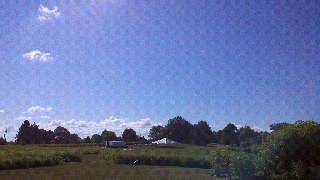See my new article about those vines you may find along your winter hikes - grape, poison ivy, and virginia creeper. Which one are you seeing and holding onto? Is it a friend or a foe? Should you be getting the camomile lotion out? Find out!
Read the article on my Our Green Neighbors blog.
Enjoy and stay warm!
-kim
Monday, December 31, 2012
Tuesday, December 18, 2012
Botanical Medicine Classes - Winter Series
We often share info about our friend Dr. Les Moore's herbal medicine classes here. His winter series of classes will be starting on January 17, 2013. You can find out more information about the series at the Classical Formulas website or via the Classical Formulas FaceBook page.
For notices about Dr. Moore's future classes I would suggest that you "like" the Classical Formulas FaceBook page.
Happy Holidays!
-kim
For notices about Dr. Moore's future classes I would suggest that you "like" the Classical Formulas FaceBook page.
Happy Holidays!
-kim
Wednesday, December 5, 2012
Jerusalem, Israel- 5th grader completes Iroquois unit
Sharing a thank you- from Niiai Arad at Ha'nisui elementary school 5th grade, Jerusalem, Israel. -Tonia
Wednesday, November 21, 2012
Native American Family Day
Sunday, December 2 from noon to 5 pm, all ages are invited to a Native American Family Day at the Memorial Art Gallery. The event, offered in conjunction with the exhibition "Changing Hands: Art Without Reservation 3," features art activities, tours, storytelling, and music and dance performances. Suggested donation is $5.
The program will include:
- Noon-4 pm: hands-on art activities for children in the Gallery¹s Creative Workshop
- 1 pm: "Napi Old Man" and "Prayer of the First Dance" by Daystar Dance Company
- 1, 2 & 3 pm: guided tours of "Changing Hands"
- 1 pm & 3 pm: Italian Baroque organ mini-recitals
- 2 pm: presentation on Native American art by Carlie Fishgold
- 2:30 pm: drum performance by Eastern Travelers
- 3 pm: storytelling presentation by Perry Ground
- 3:45 pm: interactive dance workshop by Ganondagan Young Spirit Dancers
For the complete schedule of events visit the schedule on MAG website and for more on the Memorial Art Gallery including hours and driving instructions, please Memorial Art Gallery website.
Made possible by Series Sponsor JPMorgan Chase Foundation, with additional support from the Robert and Madeleine S. Heilbrunn Memorial Fund.
Press Contacts: Meg Colombo, 585-276-8934 and Patti Giordano, 585-276-8932.
Images for Publication (press only): Images from "Changing Hands" are available for download at with the password NEWS
Thursday, November 8, 2012
Cordage Plants
 |
| Dogbane Fibers |
Read the cordage plant article...
-kim
Thursday, October 11, 2012
Ganondagan Visit to Genesee Country Village & Museum
A few weeks ago, we reached out to the fabulous 19th-century living history site, the Genesee Country Village & Museum, and what has resulted are some inspiring visits to each other's locations.

Last Friday, I spent part of the day at this marvelous historic village,
as they were in full preparation for their Agricultural Fair. The veggies at the Horticulture Tent were impressive.
I started with the Visitor Map of the extensive grounds (very helpful!) and began at the Pioneer Settlement (1780s - 1830s), stopping in at the 1822 Schoolhouse, complete with the teacher giving a lesson to a visiting family.
I couldn't resist taking photos of some of the wonderful animals, seemingly right at home and happy at the Pioneer Farmstead.
I also stopped in on a blacksmith and a woodworker and then popped in to see one of the site interpreters dyeing yarn in a pumpkin using pokeberry juice. What a great idea! I had an opportunity to have quite the chat with her about the dyeing process and about the home itself- very informative and educational.
Along the way, some kids on a field trip were having a great time trying out stilts. Kids are kids, no matter in what century:
I had to move on, and walked down the beautiful streets to the Antebellum Village (1830s - 1860s). One of the staff was doing a baking demonstration and explaining how to approximate temperatures by how many seconds you could hold your hand in the baking space (not in the fire itself!).
There were many other wonderful buildings including a wheelwright shop, a printing office, the village mercantile, an inn, shoemaker, tinsmith, tailor and much more. Also George Eastman's boyhood home, built c. 1840 and moved from Waterville, NY.
The Turn of the Century (1870s-1920s) was a big jump in both house and dress style. Have a peek.
The Octagon House certainly is a stand-out:
 Unfortunately, it was too windy to go up in the balloon, but seeing it up close certainly was impressive.
Unfortunately, it was too windy to go up in the balloon, but seeing it up close certainly was impressive.
I crossed the Great Meadow, and concluded my visit with the newly renovated and absolutely stunning John L. Wehle Gallery. It was a fantastic, and unexpected, bonus. With paintings, sculptures, and original clothing (no reproductions), it is well worth spending time viewing the offerings.
A few weeks ago, we reached out to the fabulous 19th-century living history site, the Genesee Country Village & Museum, and what has resulted are some inspiring visits to each other's locations.

Last Friday, I spent part of the day at this marvelous historic village,
as they were in full preparation for their Agricultural Fair. The veggies at the Horticulture Tent were impressive.
I started with the Visitor Map of the extensive grounds (very helpful!) and began at the Pioneer Settlement (1780s - 1830s), stopping in at the 1822 Schoolhouse, complete with the teacher giving a lesson to a visiting family.

I couldn't resist taking photos of some of the wonderful animals, seemingly right at home and happy at the Pioneer Farmstead.
I also stopped in on a blacksmith and a woodworker and then popped in to see one of the site interpreters dyeing yarn in a pumpkin using pokeberry juice. What a great idea! I had an opportunity to have quite the chat with her about the dyeing process and about the home itself- very informative and educational.
Along the way, some kids on a field trip were having a great time trying out stilts. Kids are kids, no matter in what century:
I had to move on, and walked down the beautiful streets to the Antebellum Village (1830s - 1860s). One of the staff was doing a baking demonstration and explaining how to approximate temperatures by how many seconds you could hold your hand in the baking space (not in the fire itself!).
There were many other wonderful buildings including a wheelwright shop, a printing office, the village mercantile, an inn, shoemaker, tinsmith, tailor and much more. Also George Eastman's boyhood home, built c. 1840 and moved from Waterville, NY.
The Turn of the Century (1870s-1920s) was a big jump in both house and dress style. Have a peek.
The Octagon House certainly is a stand-out:
The clouds were coming fast, and I didn't want to miss the new Civil War Encampment, with the hot air balloon "Intrepid."
 Unfortunately, it was too windy to go up in the balloon, but seeing it up close certainly was impressive.
Unfortunately, it was too windy to go up in the balloon, but seeing it up close certainly was impressive.I crossed the Great Meadow, and concluded my visit with the newly renovated and absolutely stunning John L. Wehle Gallery. It was a fantastic, and unexpected, bonus. With paintings, sculptures, and original clothing (no reproductions), it is well worth spending time viewing the offerings.
Thank you to the folks at GCVM, especially Christine Rovet and Robin Lott. You have so much to offer your visitors. We look forward to the possibility of working together with you in the near future. Stay tuned!
Tuesday, September 25, 2012
Gardening
Left- black bean picked off green vine. Pod moist and still growing. Right- same black bean picked off dried withered finished growing vine. Both picked before the first frost. Note: notice the hydration loss from the bean on right. Tomorrow We will post an after picture of both. We will note the hydration loss from the one on the left.
Tuesday, September 18, 2012
School Tour this morning
Ok so here it is...my first school group of this fall. Wasn't sun shiny matter of fact we got wet. BUT we had a good time telling stories of why trees leaves turn red yellow and orange in the fall; told one of Betty May Jumper's stories; and also,how Haudenosaunee got certain medicines! We got a whole renewed appreciation of the rain! I think Scribner Road school has some great up and coming thinkers and scientists! Kudos to the teachers and parents there.
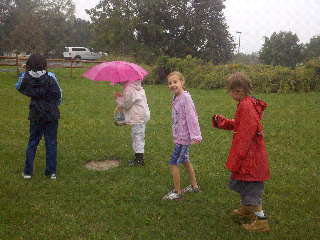
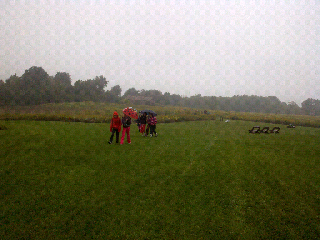


Thursday, September 13, 2012
The Secret Life of Garbage
"In our way of life, in our government, with every decision we make, we always keep in mind the Seventh Generation to come. It's our job to see that the people coming ahead, the generations still unborn, have a world no worse than ours and hopefully better. When we walk upon Mother Earth we always plant our feet carefully because we know the faces of our future generations are looking up at us from beneath the ground. We never forget them."
- from Oren Lyons
It is sad, but some of our garbage may last for the next seven generations. See more in this wonderful "Secret Life of Garbage" graphic shared with us. Hopefully it will remind all of the future generations looking to us to make better, more sustainable choices.
-kim
Created by: BusinessDegree.net
Monday, August 27, 2012
Wednesday, August 22, 2012
Visitors!!!!
Laura C. Native sister! From Pame tribe *heart* of Northern Mexico now living in San Fran, stopped in after her conference in Rochester! We spent the morning comparing and contrasting; asking each other question after question about every aspect of our native culture!!!! Niaweh (thank you) Laura, safe travels! Come back and see our new SenecaArtsCultureCentre!
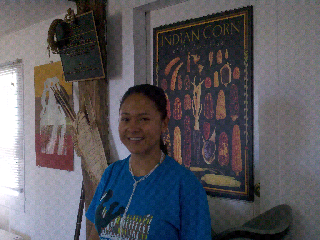

Tuesday, August 21, 2012
Thursday, August 16, 2012
The Iroquois White Corn Project
| Iroquois White Corn |
The Iroquois White Corn Project got into full swing this summer. We processed and packaged about 100 pounds of corn flour and whole white corn. The one pound bags were sold at the Ganondagan Dance and Music Festival in July.
What is Iroquois White Corn?
| Iroquois White Corn |
Where Does the Corn Come From?
Native American farmers here in our region grew the white corn for the project. After being harvested by hand in the fall, it must hang to dry. For this, it is braided in the traditional way. After it has dried a few months, the kernels must be removed from the cob. This is done manually by pushing the kernels off the cob with one's thumb. Some people use a tool to remove the kernels.How Is the Corn Processed?
If the corn is to be made into roasted white corn flour, it is roasted, ground and bagged. The White Corn Project uses a large coffee roaster for the creation of the Roasted Corn Flour product. The nutritional advantage to our white corn products is that the germ is not removed, so the products are whole grain. The flour should be refrigerated, as the oils in the germ need to be kept fresh. The germ contains vitamins and minerals, as well as fiber.White corn to be used in soup or stew (as hominy) must be treated in a lye bath to remove the outer hull on each kernel. This process is known as nixtamalization. Many people follow the traditional way to create a lye solution with hardwood ashes. That is done by rinsing the corn using a corn basket, which is a traditional tool still made by Native basket makers. These baskets are constructed of ash splints that are sized and spaced specifically for the corn washing. Throughout the region, Haudenosaunee people are still using and teaching this method.
| One of many hand-crafted steps in processing the corn |
After the corn is rinsed free from the outer shell covering and the lye, and drained, it is placed in the dehydrator. The corn takes about 4 hours to dehydrate. These kernels are bagged to be sold as Hulled White Corn. To use in a soup or stew, they must be soaked overnight, drained and then cooked according to the recipe, until soft. After dehydration the corn can also be ground to into White Corn Flour. This flour can also be used as a substitute for corn meal or blended in combination with other types of flour in recipes.
Why Iroquois White Corn?
Besides connecting connecting people with local agriculture, the Iroquois White Corn Project also connects people with history and ancient traditions.For some, it is also a personal connection with with their ancestors. As one of The Three Sisters, this corn is sacred to the Haudenosaunee people. We thought of Sister Corn as we finished up our work - her portrait hangs in our workspace and smiles down as if in appreciation.
Wednesday, August 15, 2012
Botanical Medicine Fall Classes
 |
| Native Medicine Plant - Joe Pye Weed |
There will be six different classes will be held over a period of five weeks, September 20th – October 18th 2012. Students can elect to take the entire series or individual classes. The guided herb walk for this series will be held at Ganondagan on September 22.
Please contact Classical Formulas for details and registration - their website has full class descriptions and registration information.
Of note, Classical Formulas also now has a Facebook page that you can "like" to get news about upcoming classes, lectures, and workshops as well as daily posts about herbal medicine and medicine plants.
-kim
Friday, August 10, 2012
Wednesday, August 8, 2012
Monday, August 6, 2012
Grandmother Moon
Wednesday, July 25, 2012
Saturday, July 14, 2012
Medicine Plants - Stone Root
 |
Stone Root (Collinsonia canadensis) |
Our Green Neighbors - Stone Root (Collinsonia canadensis)
-kim
Tuesday, June 26, 2012
Tuesday, June 19, 2012
Tuesday, June 5, 2012
Trailguides Needed
Ganondagan is looking for a few more people who are interested in becoming trail guides. Being a trail guide is a wonderful way to share the history of the site and of the Seneca people with visitors. Trail guides will lead visitors on guided trail walks and can be an important part of a visitor's experience of Ganondagan. Training is provided to all potential trail guides.
If you would like to learn more about our trail guide program, please see an article written by one of our long time trail guides about her experiences and the program.
If you are interested in this volunteer opportunity, please contact our Volunteer Coordinator.
If you would like to learn more about our trail guide program, please see an article written by one of our long time trail guides about her experiences and the program.
If you are interested in this volunteer opportunity, please contact our Volunteer Coordinator.
Tuesday, May 15, 2012
"Crooked Arrows" -- Catch it This Weekend
Be sure to catch special screenings starting May 18th of the movie, Crooked Arrows. The movie centers around a Native American lacrosse team and its new coach helping the team members to find pride in themselves and their heritage. See more about the movie itself at the official website.
Many of the actors and athletes in this movie are from one of the Six Iroquois Nations. See some of the list of Native actors in the film on the Crooked Arrows site or see the full cast and crew list plus reviews, trivia, and more at IMDB Movie Database. For a list of theatres showing this wonderful film, be sure to see the list on the Crooked Arrows theatre page.
After you see the movie, please share your thoughts about it on our Facebook page!
-kim
Crooked Arrows Official Movie Trailer:
Monday, May 7, 2012
May Flowers, Herbs, & Trees
May is always a time of abundant life and plants to me. It is the time when the forests become a verdant green and when wildflowers continue their spring show. It is also a busy time of gardening and planting for the coming season. To celebrate this greening of the world and the start of the new agricultural season, I take May 1st off of work. It is a 20-year old tradition. Often I spend the day in my gardens, but sometimes I take hikes or do other activities to celebrate May Day.
In that spirit of celebrating the Earth and her greening cloak, it was my pleasure to attend not one but two plant hikes over this past weekend. The first of these hikes was led by Dr. Les Moore on Saturday May 5, 2012. It was held in Phelps, NY along the Ontario Pathways Trail System. This hike focused on identification as well as the medicinal properties of the wild plants found. This hike is also part of a series of classes Dr. Moore teaches on medical herbalism. If you are interested in learning more about these classes, please see the Classical Formulas website. I created the video at the bottom of this article from the photos I took on that hike.
The second hike was at Ganondagan and it was led by Tonia Loran-Galban and Peter Jemison on Sunday May 6, 2012. This hike was along the Earth is Our Mother trail and it focused on the medicinal as well as the ethnobotanical uses of the plants along the trail. It was a beautiful day for a hike - made even more special by the abundance of the migrating red admiral butterflies. You can see the slideshow from this walk on our Plant Hike slideshow webpage.
I hope you enjoy the slideshow and video. I wish for your May to be happy and abundantly green!
-kim
In that spirit of celebrating the Earth and her greening cloak, it was my pleasure to attend not one but two plant hikes over this past weekend. The first of these hikes was led by Dr. Les Moore on Saturday May 5, 2012. It was held in Phelps, NY along the Ontario Pathways Trail System. This hike focused on identification as well as the medicinal properties of the wild plants found. This hike is also part of a series of classes Dr. Moore teaches on medical herbalism. If you are interested in learning more about these classes, please see the Classical Formulas website. I created the video at the bottom of this article from the photos I took on that hike.
The second hike was at Ganondagan and it was led by Tonia Loran-Galban and Peter Jemison on Sunday May 6, 2012. This hike was along the Earth is Our Mother trail and it focused on the medicinal as well as the ethnobotanical uses of the plants along the trail. It was a beautiful day for a hike - made even more special by the abundance of the migrating red admiral butterflies. You can see the slideshow from this walk on our Plant Hike slideshow webpage.
I hope you enjoy the slideshow and video. I wish for your May to be happy and abundantly green!
-kim
Thursday, April 26, 2012
Wild Strawberries in Bloom
 |
| Wild Strawberry, Fragaria virginiana |
One of the signs of spring has come, the blooms of the wild strawberry. The blooms herald the coming of the very tasty fruit.
If you would like to see more images as well as a video on how to identify wild strawberries, be sure to check out my new blog, Our Green Neighbors. It is dedicated to information on and images of our green friends and neighbors - the plants of our world.
Of special interest to our readers here, Our Green Neighbors will regularly feature information on medicinal and native plants as well as heirloom vegetables - being that those are some of my favorite interests. It will also feature The Herb of the Week which will be a new article each week on a selected herb.
I'll still be writing for the Friends of Ganondagan blog, but I encourage you to follow me on Our Green Neighbors as well. Enjoy!
-kim
Monday, April 9, 2012
Lily of the Mohawks
 |
| Kateri Tekakwitha (Source: Wikimedia) |
In February of this year, Pope Benedict the XVI announced that Kateri Tekakwitha would be canonized on October 21, 2012. She would be the first Native American to reach sainthood.
Kateri Tekakwitha was born in 1656 to a Mohawk father and Algonquin mother in the Mohawk village of Canaouaga or Ossernenon (modern day Auriesville) in upstate New York. She converted to Christianity at early age and led a devout Christian life. She died on April 17, 1680.
Immediately upon death, her body was said to have lost all of the disfiguring facial scars of smallpox - the same smallpox which killed the rest of her family when she was four years old - and her corpse become very beautiful. Other miraculous occurrences and indeed, miracles have been attributed to Kateri when people have used relics of hers or prayed to her for intercession on their behalf.
Sainthood is a very long process and her canonization began in 1884. On January 3, 1943 she was declared venerable by Pope Pius XII and was beatified on June 22, 1980 by Pope John Paul II. On December 19, 2011, the Congregation for Causes of Saints certified a second miracle through her intercession. The process will complete with her canonization this October.
I urge you to read more about this interesting woman and her sainthood from the sources listed below.
-kim
Learn more about Kateri Tekakwitha from the following sources:
YouTube:
"Blessed Kateri Tekakwitha"
Websites:
Wikipedia: Kateri Tekakwitha
National Kateri Tekakwitha Shrine
Shrine of Our Lady of Martyrs
Blessed Kateri, Model Ecologist
News Articles:
Montreal Gazette (Dec. 20, 2011): Sainthood Nearer for Kateri Tekakwitha
Montreal Gazette (Feb. 20, 2012): Kahnawake's Kateri Tekakwitha to be Canonized Oct. 21
Times Union (Feb. 20, 2012): Kateri to be Canonized in October
Books:
A Lily Among Thorns: The Mohawk Repatriation of Kateri Tekakwitha by Darren Bonaparte
Thursday, March 22, 2012
Signs of Spring Redux - Snakes Awake
I must start off by saying that I lived most of my life with an irrational fear of snakes. I would have rather faced a charging, rabid grizzly bear than a couple of inch slithering garter snake. I was taught from little up to be afraid of them. My mother, who was a strong presence and in my child's mind afraid of absolutely nothing, was petrified of them. She screamed when she saw them. She couldn't stand to see them on tv and would leave the room if they came on one of the many nature shows we watched like "Wild Kingdom." She would even tape or staple the pages together of our Ranger Rick magazine if there happened to be a snake article - I have an incredibly vivid and amusing memory of that!
While not as extreme as my mom - I could watch them on tv, see them in books, look at them in the zoo or if a handler was showing a snake, I still shrieked and ran when I saw them in the wild. Tiny, little harmless snakes. I must say that surprised the heck out of my kids when they first saw that reaction out of me. They never see me scream or show fear like that. I tend not to be a person given to extremes and this was clearly an extreme.
My oldest, who must have been 6 years old at the time, tried to comfort me. With his hand patting me he said, "It's ok, mommy. It's just a little snake. He's really little. He's going away." Boy, does that make you feel silly! But proud too that you raised a compassionate human being who stepped up when he saw someone else needed strength and comfort.
I suspect it started that day, but in the years since I've come to kind of a truce with snakes. If we keep to our own spaces and there is no surprise appearances directly underfoot, I can get by. No more shrieking or running. I can even watch them in the wild, at a polite distance though!
This spring we figured out that garter snakes like to use an area at our place, which is one of the many old hand-dug wells on the property, for a winter denning spot. From what we saw, we guessed maybe a dozen snakes had been woken by our unusually warm early spring weather. My children loved the show the snakes put on. The slither this way or that around the old well. My youngest remarked that, "Nature is amazing!" She surely is.
I snapped a few pictures of our legless visitors. I share two below - saved for the last in case you too are like my mom and can't stand to even see pictures of them. Since snakes also have their place in the world, I hope you can find your truce with them as well.
-kim
While not as extreme as my mom - I could watch them on tv, see them in books, look at them in the zoo or if a handler was showing a snake, I still shrieked and ran when I saw them in the wild. Tiny, little harmless snakes. I must say that surprised the heck out of my kids when they first saw that reaction out of me. They never see me scream or show fear like that. I tend not to be a person given to extremes and this was clearly an extreme.
My oldest, who must have been 6 years old at the time, tried to comfort me. With his hand patting me he said, "It's ok, mommy. It's just a little snake. He's really little. He's going away." Boy, does that make you feel silly! But proud too that you raised a compassionate human being who stepped up when he saw someone else needed strength and comfort.
I suspect it started that day, but in the years since I've come to kind of a truce with snakes. If we keep to our own spaces and there is no surprise appearances directly underfoot, I can get by. No more shrieking or running. I can even watch them in the wild, at a polite distance though!
This spring we figured out that garter snakes like to use an area at our place, which is one of the many old hand-dug wells on the property, for a winter denning spot. From what we saw, we guessed maybe a dozen snakes had been woken by our unusually warm early spring weather. My children loved the show the snakes put on. The slither this way or that around the old well. My youngest remarked that, "Nature is amazing!" She surely is.
I snapped a few pictures of our legless visitors. I share two below - saved for the last in case you too are like my mom and can't stand to even see pictures of them. Since snakes also have their place in the world, I hope you can find your truce with them as well.
-kim
 |
| The biggest of the garter snakes we saw - compare to the dandelion leaves |
 |
| Some were more brown in color |
Thursday, March 8, 2012
Directions from Arts Center to Medaille Formal Lounge
When entering in through the Arts Center main entrance, take the first flight of stairs you see.
From there, walk forward until you reach the Art Gallery sign and take a left.
Keep walking forward until the end of the corridor, then turn left and go down the corridor and leave through the door that leads outside.
Proceed forward until there is a split in the sidewalks, take a left (the middle path) not the sharp right and you should see a line of large buildings. These are the residence halls.
The first building that is closest to you should have a sign in the front indicating it is Medaille.
Go in the first entrance of Medaille and go up to the first floor.
Go through the doors and the Medaille formal lounge should be on your left.
The doors should be open during event time.
From there, walk forward until you reach the Art Gallery sign and take a left.
Keep walking forward until the end of the corridor, then turn left and go down the corridor and leave through the door that leads outside.
Proceed forward until there is a split in the sidewalks, take a left (the middle path) not the sharp right and you should see a line of large buildings. These are the residence halls.
The first building that is closest to you should have a sign in the front indicating it is Medaille.
Go in the first entrance of Medaille and go up to the first floor.
Go through the doors and the Medaille formal lounge should be on your left.
The doors should be open during event time.
Community Read
Nazareth College will be presenting a community read revolving around the book To Become a Human Being.
Place: Medaille Formal Lounge on the Nazareth College Campus at
4245 East Ave Rochester, NY 14618
Parking: Arts Center Parking Lot
Date: March 21, 2012
Time:7:00 to 8:30PM
What: We will be split up into small discussion groups of 8 and there will be refreshments as well. The directions from Arts Center to Medaille will be up soon and there will also be students that can help guide people to Medaille should they become lost.
We hope to see you there for the discussion of this great book!
Place: Medaille Formal Lounge on the Nazareth College Campus at
4245 East Ave Rochester, NY 14618
Parking: Arts Center Parking Lot
Date: March 21, 2012
Time:7:00 to 8:30PM
What: We will be split up into small discussion groups of 8 and there will be refreshments as well. The directions from Arts Center to Medaille will be up soon and there will also be students that can help guide people to Medaille should they become lost.
We hope to see you there for the discussion of this great book!
Wednesday, March 7, 2012
Signs of Spring!
While some look for signs of spring in the plant world such as pussy willows and skunk cabbage blooms, others look to our feathered friends to harken the season.
Many look for the American Robin to return, but I find them to be poor weathermen. Too often I have seen them shivering in snowstorms! There are, however, birds that are much better predictors of the coming season. I personally I have seen Turkey Vultures in the past two weeks. They are migratory birds who return to this area each spring with much better accuracy than the robin.
Another sure harbinger of the impending spring is the Redwing Blackbird. The following picture was submitted to us. It is of the first person to spot a redwing blackbird at Ganondagan. Very nice!!
If you have seen any signs of spring at Ganondagan that you wish to share, please send your photos to us at friends@frontiernet.net!
-kim
Many look for the American Robin to return, but I find them to be poor weathermen. Too often I have seen them shivering in snowstorms! There are, however, birds that are much better predictors of the coming season. I personally I have seen Turkey Vultures in the past two weeks. They are migratory birds who return to this area each spring with much better accuracy than the robin.
Another sure harbinger of the impending spring is the Redwing Blackbird. The following picture was submitted to us. It is of the first person to spot a redwing blackbird at Ganondagan. Very nice!!
If you have seen any signs of spring at Ganondagan that you wish to share, please send your photos to us at friends@frontiernet.net!
-kim
 |
| Redwing Blackbird spotted at Ganondagan |
Monday, March 5, 2012
Botanical Medicine Certificate Program
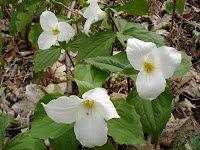 |
| Native Medicinal - Trillium grandiflorum |
Please contact Classical Formulas for details and registration. See their website for more details.
-kim
-----------------
Botanical Medicine Certificate Program - Medical Herbalism Part III
April 26, 2012 through May 24, 2012
(Previous students: NOTICE A START DATE CHANGE!)
 |
| Native medicinal - blackberry (Rubus sp.) |
Dr. Moore has an extensive background and education in the field of botany and Herbalism, both eastern and western. Dr. Moore received a Doctorate of Naturopathic Medicine and a Master of Science in Oriental Medicine from the National College of Naturopathic Medicine.
You may register for the whole series, or at the beginning of each class. If you choose to register per class, please give us advance notice so that we have enough materials made for you. Students may begin ANY series at ANY time with no prerequisite of a previous series - each series is an independent module. Students completing all three of the series (Parts I, II & III) will receive a certificate upon attendance verification and program completion. Class size is limited.
 |
| Chamomile blooms (Matricaria chamomilla) |
COST: $120 for the series or $25 per class.
Contact: Classical Formulas for registration at 315-462-0190 by Friday, April 20, 2012.
PLEASE NOTE: All classes are held on Thursdays at Clifton Springs Hospital from 6:30-8:30 pm with the exception of the herb walk on Saturday May 5, 2012, which we be held at the Ontario Pathways Trail, Phelps, NY at 9:00am.
Keep watch for information about the Homeopathy program and a date for the Homeopathy program information session....
Medical Herbalism Part III - Course Descriptions
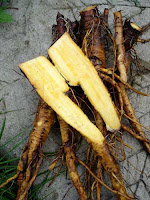 |
| Yellow Dock Root (Rumex crispus) |
Learn about herbs to soothe gastrointestinal tract, nervous system, digestion, allergies and detoxification.
Class 2 - Herb Pairs/Drug Interaction and Adjunctive Cancer Therapy - May 3, 2012
This class will focus on paired herbs that are therapeutic for specific conditions. Information on interactions that can occur between medicines and herbs will also be discussed as well as herbal dosages for children.
Class 3 - Plant Identification/Herb Walk - May 5, 2012
This class will be a 3 hour walk to identify plants in the surroundings area. You will learn about their habitat, history and uses. This class will meet at the Ontario County Pathways trail, Route 96, Phelps, NY. Bring water and snack, dress for the weather and wear appropriate footwear.
Class 4 - Herbal Therapeutics - May 10, 2012
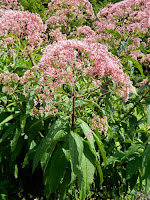 | |
| Native Medicinal - Joe Pye Weed |
Class 5 - Herbal Medicine Making - May 17, 2012
Let food be your medicine and medicine be your food. Healthy eating, herbal teas as well as discussing wild crafting and tips on drying and storing herbs.
Class 6 - Herbal Formulas and Modifications - May 24, 2012
Herbs used in herbal formulas can act synergistically and can be tailored for each unique individual, even as a person or environment changes. This class will consider how formulas can be used and altered to address specific changes.
Friday, March 2, 2012
Beautiful Blooms
 |
| An orchid at the Sonnenberg Orchid Show |
While the orchids at the show mostly hail from various tropical locations, the orchid family is a very wide-ranging group and can be found on every continent save Antarctica. What may be surprising to most people reading this, is that orchids comprise the second largest plant family after asters with over 20,000 different species.
Did you also know there are wild orchids growing right here in NY State? Around 60 species of orchid are native to New York, though a third of them are rare to see since they are considered endangered or threatened. Unfortunately the orchids here are like many plants - they struggle to survive in their native ranges. Recently I ran across the following piece of information:
"At least one of every eight plant species in the world - and nearly one of three in the United States - is under threat of extinction, according to the first comprehensive worldwide assessment of plant endangerment." --- ”Plant Survey Reveals Many Species Threatened With Extinction,” NY Times, April 19, 1998
 |
| The native grass pink orchid (Zurich Bog) |
I urge you to visit Sonnenberg this weekend. Celebrate the beauty and diversity of one of Mother Earth's gifts, the orchid. I hope the blooms lift your grey winter spirits as much as it did mine!!
-kim
More information on NY State Orchids:
"Orchids of New York" By Chuck Sheviak and Steve Young
"Native New York Orchids" (YouTube)
New York Flora Atlas - Orchids
Tuesday, January 31, 2012
Seeing the Possibilities
 |
| Recycle Craft - Candy Wrapper Flowers |
The Seneca used the inedible dry corn husks to create dolls, mats, containers, and more. The Europeans used wheat and oat straw for similar purposes. Go the world over and you will find countless other such examples of this inventive re-purposing.
And in looking around the world, you will also find that many of these examples of re-purposing have grown not only into cherished traditional crafts and arts, they have become elements of the culture that created them. Many have created dolls from dried plant materials to be sure, but what is more Haudenosaunee than a faceless cornhusk doll?
Whether it was generations of farming traditions or grandparents living through hard times like the Depression and post-WWI Germany, the "do-it-yourself" and "waste-nothing" attitudes were deeply ingrained in me while growing up. Being wasteful was just behind poor hospitality and dishonesty as sins in my house. Saving things that could some day be used was expected.
Many people in both my extended and immediate family have artistic and musical talents - with many varied paths of expression though. I'm no exception to my family and have my own talents. While I certainly can draw and paint, it is not my forte or my greatest love. But crafts - and I have tried many, are. I have tried so many different arts that I usually tell people that blowing glass and casting metal are two of the only ones I haven't tried.
I started my own journey as a craftsman and artisan at 8 years old. In those days, I had no money and no access to craft stores even if I did. So in a day when no one recycled, I did. I saw the possibilities in items destined for the garbage can. I saved them and literally had boxes of those "recycled" supplies.
Now many decades later with access to craft stores and the money for supplies, I still see with those same eyes. I can still see the possibilities lying below the surface of what others would call trash. Perhaps you can too. Here are the instructions for creating a whole bouquet of candy wrapper flowers that I came up with on Valentine's Day a few years ago. I hope you enjoy this and start your own eyes looking for those possibilities!
-kim
Friday, January 20, 2012
Creator’s Garden Medicine Plants: Da'ja's
 |
| Creator's Garden in Winter |
Many of the plants in the garden are labeled so visitors may tour the garden on their own. The labels include the English, Seneca, and botanical name for the plants. (Note: the signage is usually stored for the winter.)
One of the plants you will find in the Creator's Garden is a matched pair (male and female) of the native shrub, the spicebush.
Da’ ja’s (Spicebush, Lindera benzoin)
Da’ja’s (Seneca name) or spicebush is a medium-sized shrub (16’) that is often found in the shady, forest understory. Its foliage is aromatic with a unique scent that is somewhat like a cross between lemons and sassafras. The spicebush is dioecious (individual plants are either male or female) and so a pair of these plants is necessary to produce berries with a viable seed.
| Spicebush (Lindera benzoin) |
The spicebush is the favorite host plant for the Spicebush Swallowtail (Papilio troilus) and the Promethea Silkmoth (Callosamia promethea).
The spicebush, native to North America, makes a wonderful specimen plant to add to your own landscaping. While it is typically an understory plant growing in full-shade, it grows quite nicely in the full-sun - as it does in the Creator's Garden. This hardy and pest-free plant requires no pruning or maintenance of any kind once established. Add multiple plants (at least 1 male and 1 female plant) if you are interested in having berries on the female plant. It is a wonderful alternative to exotic, hard-to-keep, and/or invasive ornamental shrubs.
1. Iroquois Medical Botany by James W. Herrick
-kim
Subscribe to:
Posts (Atom)





















